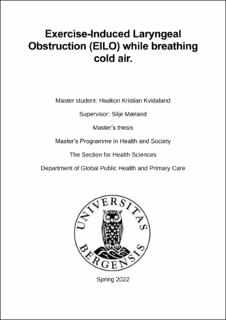Exercise-Induced Laryngeal Obstruction (EILO) while breathing cold air
Master thesis
Permanent lenke
https://hdl.handle.net/11250/3001383Utgivelsesdato
2022-05-16Metadata
Vis full innførselSamlinger
- Master theses [141]
Sammendrag
Introduction: Exercise-induced laryngeal obstruction (EILO) is important to consider when investigating patients with exercise-induced dyspnea. The gold standard in EILO-diagnostics is the Continuous Laryngoscopy Exercise test (CLE test), visualizing laryngeal response patterns during a standardized treadmill exercise test with increasing workload until maximal effort. Although literature reports more symptoms of EILO during exercise in cold air, compared to room air, no studies have systematically investigated a potential difference. Aims: To evaluate a potential difference in laryngeal obstruction when breathing cold air compared to room air, among young adults (suspected of EILO. Methods: In this randomized crossover design, nine patients (29.8 (21-38) years (mean (range)) suspected of having EILO were included. They performed, in random order, two standard CLE tests, one while breathing cold air (-15°C) and one while breathing room air (20-22°C). The degree of laryngeal closure was scored using standard CLE score at moderate and maximal effort on glottic, and supraglottic level. A higher CLE score indicates more laryngeal closure. Results: There was no difference in the CLE sum score (0.1(-0.7-0.5) (mean difference (95%confidence interval (CI)). When breathing cold air during the CLE tests, the mean difference in test duration were 15 seconds shorter (2-28 (95%CI)), and the supraglottic closure at moderate effort was higher at an identical workload (0.6 (0.2-1) (mean difference (95%CI)), compared to when breathing room air. Conclusion: Breathing cold air compared to room air did not influence the CLE sum score. The patients ran for a shorter period when breathing cold air, and supraglottic obstruction was more prominent at moderate effort. More extensive studies with more patients are needed.
Utgiver
The University of BergenOpphavsrett
Copyright the Author. All rights reservedBeslektede innførsler
Viser innførsler beslektet ved tittel, forfatter og emneord.
-
The relationship between exercise-induced cardiac Troponin increase and physical workload during prolonged strenuous exercise : North Sea Endurance Exercise Study (NEEDED) 2018
Bjørkavoll-Bergseth, Magnus (Doctoral thesis, 2024-06-06)Bakgrunn Høye nivåer av kardial troponin (cTn) er knyttet til økt dødelighet og en høyere sjanse for udiagnostisert koronararteriesykdom (CAD). Denne avhandlingen hadde som mål å undersøke sammenhengen mellom treningsintensitet ... -
Exercise related respiratory problems in the young—Is it exercise-induced bronchoconstriction or laryngeal obstruction?
Vollsæter, Maria; Stensrud, Trine; Maat, Robert; Halvorsen, Thomas; Røksund, Ola Drange; Sandnes, Astrid; Clemm, Hege Synnøve Havstad (Journal article; Peer reviewed, 2022)Complaints of breathlessness during heavy exercise is common in children and adolescents, and represent expressions of a subjective feeling that may be difficult to verify and to link with specific diagnoses through objective ... -
Regular consumption of cod liver oil is associated with reduced basal and exercise-induced C-reactive protein levels; a prospective observational trial: A NEEDED (The North Sea Race Endurance Exercise Study) 2014 sub-study
Hansen, Mette Wærstad; Ørn, Stein; Erevik, Christine B.; Bjørkavoll-Bergseth, Magnus Friestad; Skadberg, Øyvind; Melberg, Tor Harald; Aakre, Kristin Moberg; Kleiven, Øyunn (Journal article; Peer reviewed, 2021)Background Dietary supplement use among recreational athletes is common, with the intention of reducing inflammation and improving recovery. We aimed to describe the relationship between omega-3 fatty acid supplement use ...
